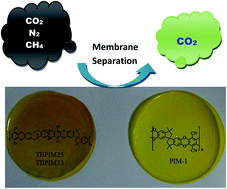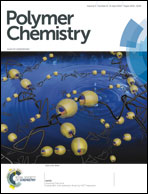Tröger's base-based copolymers with intrinsic microporosity for CO2 separation and effect of Tröger's base on separation performance†
Abstract
“Polymers of intrinsic microporosity” (PIMs) have recently received considerable attention as powerful and promising membrane materials for gas separation, especially for CO2 separation. In this work, a new type of PIM copolymer derived from 2,3,8,9-tetrahydroxy-6H,12H-5,11-methanodibenzo[b,f][1,5]diazocine (THTB) and 5,5′,6,6′-tetrahydroxy-3,3′,3′,3-tetramethylspirobisindane (TTSBI) copolymerized with 2,3,5,6-tetrafluoroterephthalonitrile (TFTPN) was synthesized and their properties for CO2 separation were investigated. The molecular structures of the copolymers were characterized by 1H NMR and the molecular weights were determined by GPC. Gas transportation measurements demonstrated that the TB-based copolymers exhibit an improved selective capacity for the separation of CO2/N2, CO2/CH4 and O2/N2, while showing a small decrease of permeability. A detailed investigation on the effect of TB on the performance of the copolymers was undertaken by wide-angle X-ray diffraction analysis, BET and fractional free volume measurements, and molecular modeling analysis. It was concluded that the introduction of TB units in the copolymers leads to more efficient chain stacking and gives the copolymers a smaller pore width distribution as compared to the homopolymer derived only from TTSBI and TFTPN (referred as PIM-1). As a consequence, the introduction of TB enhanced the CO2 selectivity, owing to the increase of CO2 solubility when passing through the copolymer membranes.


 Please wait while we load your content...
Please wait while we load your content...